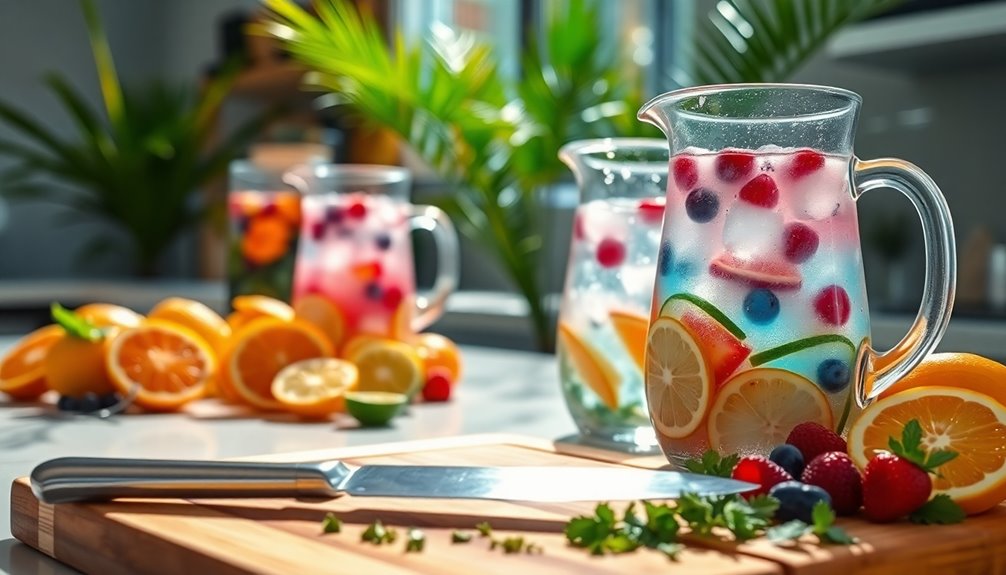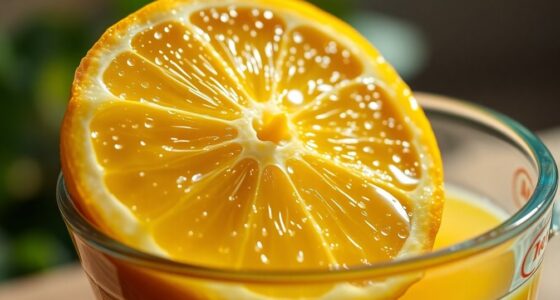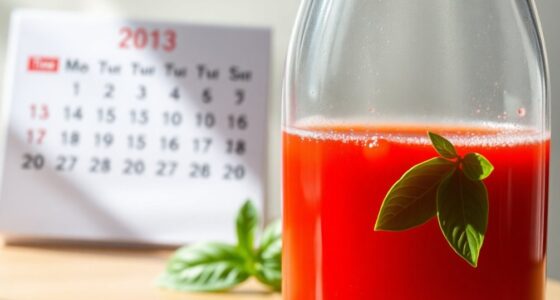To make Jungle Juice, combine vodka, rum, lemonade, orange juice, and optional cranberry or pomegranate juice in a large bowl. Mix well to blend the flavors and adjust sweetness as needed. Let it sit for up to 12 hours to infuse. Add fresh fruit slices like oranges and strawberries for extra flavor and flair. Serve it over ice, and consider adding tonic water or prosecco for a fizzy finish. Discover more tips for the perfect punch!
Key Takeaways
- Combine vodka, rum, lemonade, and fruit juices in a large punch bowl for a flavorful mix.
- Let the mixture sit for up to 12 hours to enhance flavor infusion.
- Add fresh fruit like sliced oranges and strawberries for an appealing presentation.
- Serve Jungle Juice over ice and store leftovers in the fridge for up to two weeks.
- Consider adding tonic water or prosecco for a fizzy twist before serving.

Jungle Juice is a fun and fruity punch that's perfect for parties, and it's surprisingly easy to make. If you're looking to impress your guests with a delicious drink, this Easy Jungle Juice recipe is the way to go. Combining the right balance of alcohol and fresh fruit creates a vibrant tropical punch that'll keep everyone refreshed and having a good time.
To start, grab a full 750-milliliter bottle of vodka and a bottle of rum. These two spirits are the backbone of your Jungle Juice, giving it that delightful kick you want. You can choose to use light or dark rum, depending on your preference.
Once you have the alcohol, it’s time to get your fruit juices ready. You’ll want a mix that includes lemonade, orange juice, cranberry juice, and if you’re feeling adventurous, some pomegranate juice. Pour your alcohol and juices into a large punch bowl or drink dispenser, and mix them well. Next, consider adding some fresh fruit slices to enhance the visual appeal and taste of your punch. You can also experiment with herbs like mint for a refreshing twist. If you’re interested in exploring further, researching how to create e juice flavors can inspire you to personalize your drink with unique combinations!
Now, here's where you can get creative with your flavor. You can adjust the sweetness and strength of your punch by varying the quantities of juice and alcohol. If you want a stronger drink, add more alcohol; for a sweeter taste, increase the juice.
For the best flavor infusion, consider letting your Jungle Juice sit for up to 12 hours before serving. This waiting period allows all those flavors to meld beautifully, enhancing the overall taste.
To elevate your tropical punch experience, don't forget to add fresh fruit! Sliced oranges, strawberries, and pomegranate arils not only contribute to the flavor but also make your punch bowl look visually appealing. The fresh fruit pieces floating in the mix are bound to catch your guests' eyes and will encourage them to dig in.
When it's time to serve, pour the Jungle Juice over ice in cups or jars. This keeps your punch nice and chilled while adding a refreshing touch. If you happen to have leftovers, you can store them in the fridge for up to two weeks, or even freeze the mix for future use. Just be sure to leave out any fizzy ingredients until you're ready to serve.
For an extra twist, consider mixing in some tonic water or prosecco just before serving. This addition gives your Jungle Juice a delightful fizz, taking your fruit punch to the next level.
With this recipe, you won't just taste the alcohol; you'll enjoy a balanced blend of flavors that will keep the party going. So gather your ingredients, put on your favorite tunes, and get ready to enjoy a fabulous Jungle Juice that'll have everyone raving about your drink-making skills!
Frequently Asked Questions
What Is Jungle Juice Made Of?
Jungle juice is a fruity mix of various juices, often including lemonade, orange juice, and cranberry juice.
You'll typically find vodka and rum as the primary alcoholic components, creating a strong punch.
Fresh fruits like oranges, strawberries, and pomegranate seeds add flavor and visual appeal.
You can customize your jungle juice by swapping different types of alcohol or juices, making it perfect for any occasion or personal taste preference.
What Are the Components of Jungle Juice?
You know what they say, "Variety is the spice of life!"
When it comes to jungle juice, its components are all about mixing flavors. You'll typically use fruit juices like lemonade, orange juice, and cranberry juice to create a refreshing base.
Add in some vodka and rum for that kick, and don't forget fresh fruits like oranges and strawberries for extra flavor.
Feel free to experiment with different juices and liquors to suit your taste!
How Much Alcohol Does Jungle Juice Have?
Jungle juice typically has about 20% alcohol by volume (ABV), but this can vary based on how much juice or soda you mix in.
When you enjoy a standard batch, which can yield 2 to 2.5 gallons, you're likely consuming a mix that includes a full 750-milliliter bottle of vodka and rum combined.
Just remember, the fruity flavors can mask the alcohol's strength, so it's easy to underestimate how strong it really is.
How to Make Jungle Juice for Pregnancy?
To make a pregnancy-friendly version of jungle juice, you'll want to skip the alcohol and focus on delicious fruit juices.
Mix together lemonade, orange juice, and pineapple juice, then add some sparkling water for fizz. Toss in fresh fruit like strawberries and oranges to enhance the flavor and make it visually appealing.
Remember to use pasteurized juices to ensure safety during pregnancy. Serve it chilled in fun cups for a festive touch!
Conclusion
Now that you know how to make jungle juice, you can whip up this fun party drink in no time. Just remember, it's all about balancing flavors and having a little fun with your ingredients. Once you've got your recipe down, you'll be the life of the party. So, don't hesitate—dive in and let your creativity flow! After all, when it comes to mixology, you've got to break a few eggs to make an omelet!
Cindy thoroughly researches juicing trends, techniques, and recipes to provide readers with practical advice and inspiration. Her writing style is accessible, engaging, and designed to make complex concepts easy to understand. Cindy’s dedication to promoting the advantages of juicing shines through her work, empowering readers to make positive changes in their lives through the simple act of juicing.
















